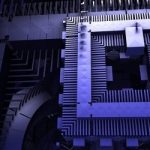Making Diamond Qubits Talk to Light

(Phys.aps.org) Networks of quantum-entangled qubits could transform communication and computation, enabling a fundamentally secure quantum internet or a universal quantum computer. Photons seem to be the best option for connecting the qubits, or “nodes,” because they can travel great distances along well-defined paths through waveguides, fibers, or free space. For the node, there are many more contenders, including trapped ions, trapped atoms, warm atomic vapors, quantum dots, rare-earth dopants in a crystal, and defects in diamond called nitrogen vacancy centers. However, none of these options are ideal, and each must satisfy multiple physical requirements at once. Three of the most important criteria have now been met by a relative newcomer to the qubit arena—a silicon point defect embedded in diamond. Focusing on one such defect, Christian Nguyen and colleagues at Harvard University report that they can read out its state in a single shot, make it communicate efficiently with photons, and couple it to a long-lived quantum memory. This demonstration is the first time all three of these conditions have been met together in a solid-state system, which is considered the most scalable qubit option.



















